Breeding and applications of varieties in medicinal plant production
Author: Éva Németh Zámboriné
Situation of variety development, spectrum of cultivars
For the quality assurance of drugs and other products based on medicinal plants, a starting point is the availability of plant material (species, varieties, intraspecific taxa, populations, etc.). Although the quality of the harvested goods may be influenced by several other factors like agro technology, habitat, year, etc. moreover many of them effects also the wild collected species, genetic background is of basic significance. Fulfilling the requirements for special chemical ingredients, for proper yield and economical sustainability or even the possibility of applying special technologies of high efficacy can be only achieved by plant genetic material (cultivar, strain, population, etc.) of well known and stable properties. This principle is gaining more and more emphasis in production of medicinal and aromatic plants, which is in connection with the development of quality assurance systems, with the stringent requirements for standardized products.
In 2012 in Hungary we had 55 varieties of 25 different medicinal and aromatic plant species listed in the so called National List of Registered Varieties. However, a real choice for varieties exists only in case of poppy (Papaver somniferum) and white mustard (Sinapis alba) because the majority of the species possess solely a single variety.
Poppy cultivars registered in Hungary
-
Name of variety
Year of registration
Direction of use
Ecotype
Alfa
2004
Industrial
Spring
Ametiszt
2003
Food
Spring
Botond
2006
Industrial
Spring
Buddha
2004
Industrial
Spring
Csiki kék
2004
Industrial
Spring
Eleonora
2011
Industrial
Spring
Evelin
2003
Industrial
Spring
Fortemo
2011
Industrial
Spring
Kék Duna
1973
Food
Spring
Kék Gemona
1995
Industrial
Spring
Korona
2008
Industrial
Spring
Kozmosz
1983
Food
Winter
KP Albakomp
1998
Food
Spring
Leila
2008
Food
Winter
Minoán
2005
Industrial
Spring
Morvital
2011
Industrial
Spring
Morwin
2009
Industrial
Spring
Nigra
2003
Industrial
Spring
Postomi
2004
Industrial
Spring
Tebona
2000
Industrial
spring
Zeno Plus
2009
Food
Winter
Zeno V56
2009
Food
Winter
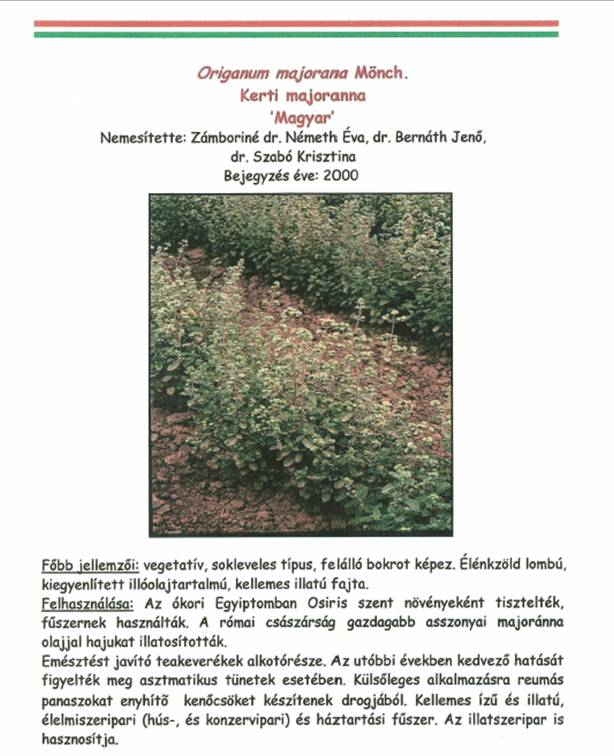
Description of marjoram variety ‘Magyar’
Comparing this number to the number of registered varieties in any of the branches of horticulture, we can establish that it is very poor, even if there are some varieties registered not in the list of medicinal plants but elsewhere like sea buckthorn (Hippophae rhamnoides) among fruits or basil (Ocimum basilicum) or dying mallow (Alcea rosea) as ornamental plants. There is not a so-called Descriptive Variety List or List of Recommended Varieties for any variety of medicinal plant species. The situation is similar in other countries involved in medicinal plant production, too. The background of the poor spectrum of varieties of medicinal and aromatic plant species can be summarized as follows:
-
In case of medicinal plant cultures, the income by selling the propagation material seems not to be significant and attractive enough because of the relatively small cultivation surfaces of these crops.
-
In case of the majority of species no alternative technologies or specialized processing methods have been developed till recent times, which require different genotypes of really varying properties and qualities.
-
Import of foreign cultivars –as it is an alterative in other horticultural branches like vegetable production, etc. - has not been a realistic solution either, because even in other countries there is a very poor choice or no varieties of medicinal plants at all.
The majority of existing cultivars can not be considered as up-to date, either. Many of them were released 40 years ago (!) and most of them were developed 5-15 years before, therefore their performance is below the requirements today. As a consequence, in the practice we use, instead of the officially registered varieties, different introduced populations or not closely defined accessions, which are propagated without control. It happens when the officially released varieties can not be cultivated economically any more or their propagation materials are not available.
In Hungary, the Law nr. 2003. LII. contains the official paragraphs about recognition of cultivars (varieties) and multiplication, propagation of seed material. The regulation on the official recognition of cultivars is formulated in the Ministerial Decree Nr. 40/2004.(IV.7.) FVM. Some medicinal plant species like poppy, caraway, mustard species, safflower and flax belong to the group of the large scale crops which must not be marketed without a proper name of cultivar and without a field control by the auditing authority (species of “A” list). The requirements for distribution of such large scale crops have been included in Ministerial Decree2004. (IV.21.) FVM.
For the majority of medicinal and aromatic plant species there is no obligation for using exclusively the permitted propagation material of an officially registered variety but they are allowed to be brought onto the market even without a variety name (e.g. marjoram, lavender, milk thistle, etc). Formerly, this group of species has been called species of “B” list. However, even the propagation, distribution of these species should consider the general regulations, respecting the limit values for purity and germination capacity. These properties should be verified by NÉBIH (National Legislation Office) in frame of the seed certification procedure.
This type of regulation however, does not mean that medicinal plant species do not need being improved and developed by breeding activity. The demand for genotypes accumulating special active ingredients or individual properties fitting for processing treatments is growing all over the world. Demands are coming from both sides, from the farmers and processing industry as well. Agricultural producers are interested in using varieties of high yields, stress tolerance, ontogenetical and morphological uniformity, appropriate features for mechanization, etc. The processing industry – both small and large scale – considers the chemical composition, the stable quality as primarily important characteristics. Today, obviously the needs of this latter one direct the goals of breeding of medicinal plants. Numerous examples –mainly form Europe and US - can prove that the basis of any up-to date product at the top of the production chain is the well established, selected biological raw material included into the total quality management system. Therefore these companies direct the breeding according to their goals and are financing it for the long run. It can be observed that the majority of processing companies does not seek after an official variety registration procedure as seeds will be distributed in a closed system among the farmers with bilateral contracts. Some gene stocks showing exceptionally high value are defended by national or international patent which is able to protect the breeder’s right more effectively (e.g. ergot, poppy, clary sage).
Among the horticultural crops, breeding of medicinal plant species seems to have several difficulties, as described. A broad spectrum of species, a wide taxonomic and technological diversity of cultures, many different breeding goals according to the utilisation are characteristic. On the other side, medicinal plant products possess a relatively tighter range and lower, fluctuating market turnover, have smaller cultivation surfaces therefore the return of any investment into the breeding activity seems to be less certain and expectedly lower than in case of related horticultural or field crops. On the contrary to other species of economically higher significance, realization of the royalty fee is practically impossible. The return is even more uncertain as juristic procedure in case of illegal use is difficult because most of the varieties are easy to propagate and hard to prove. A further characteristic feature of medicinal plant breeding is the fact that development of new genotypes relies on a wide number of laboratory analysis which contributes to the multiplication of costs.
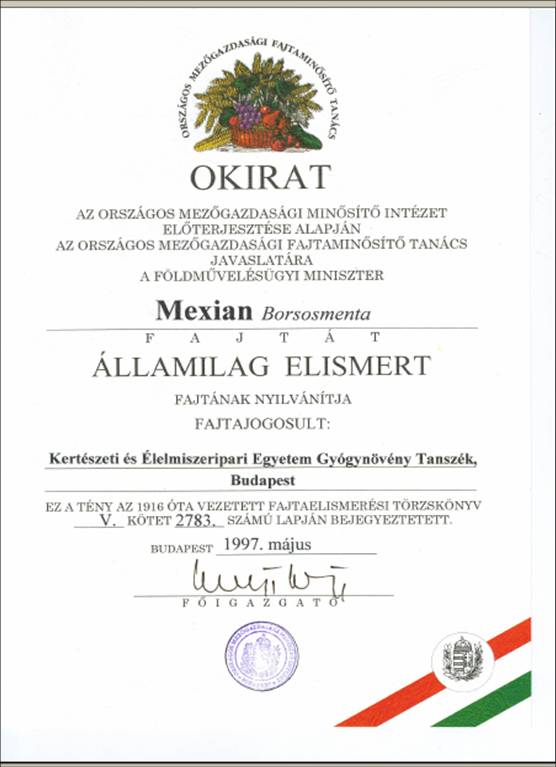
Document for variety certification
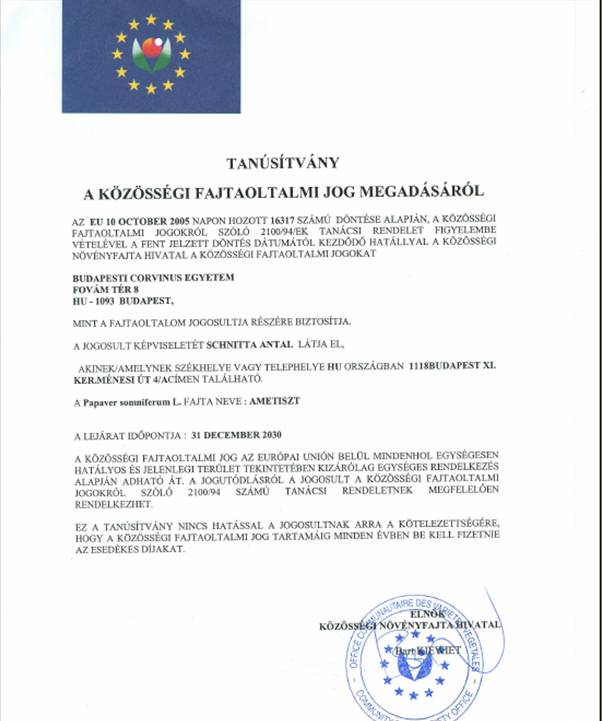
Document for a patent on plant variety
Lack of information is deepening the difficulties of genetic development of our species too, as in numerous cases the knowledge on inheritance, floral biology and cultivation methods is restricted. It is even more characteristic for the recently introduced species (e.g. Centaurium erythraea, Verbena officinalis, Petasites hybridus, Primula veris, etc.).
Successful evaluation, registration of plant cultivars and at the same time protection of intellectual property rights is encumbered by the fact that DUS (Distinctness, Uniformity, Stability) examination protocols required by UPOV are not available for the majority of medicinal plant species. They have been elaborated for only a small number of them, like poppy, fennel, lavender, chamomile (Figure 2.4.).
Figure 2.4.DUS guideline for examination and evaluation of chamomile variety candidates
( gyogy 2.4a.pdf )
The number of breeding firms specialized in medicinal plants is limited. While 20-30 years ago Hungary could be considered as unique for offering a relatively wide spectrum of medicinal plant cultivars, today there are some breeder estates almost in each country. By the enlarging market of plant based medicines, dietary supplements and similar products, more and more varieties are being developed in the world. There is a tendency for preference and use of own cultivars for each country. In Eastern Europe, multiplication of seed stocks is increasing because of the generally more advantageous ecological circumstances. However, sometimes even our farmers are unable to obtain a good and reliable seed material in the market for their production.
Goals of medicinal plant breeding
Goals of medicinal plant breeding- compared to other horticultural crops- are characteristically different to some extent. These characteristic features are summarized in the following paragraphs.
Breeders are always straining for an enhanced yield. Here, the enhancement is not focused on the total biomass but especially on the organs which provide the medicinally useful drug. Thus, increase of root mass and optimising root morphology are the goals in the breeding of valerian (Valeriana officinalis) today. Increase of shoot mass and improvement of leaf proportion compared to total shoot mass is the goal –among others – in breeding of mint species (Mentha spp.), basil (Ocimum basilicum) or lemon balm (Melissa officinalis). Yield of upper flowering parts –the so-called flowering horizon of the shoots- is of primary importance inside the total biomass in breeding of some species providing herbal drugs like St. John’s Worth (Hypericum perforatum) or motherworth (Chrysanthemum parthenium). Enhancement of regeneration capacity would increase the yield of several species through the possibility of multiple harvests in the same year. This may contribute to the economics of the crop production in cultures of thyme (Thymus vulgaris), marjoram (Majorana hortensis) and similar species.
Increase of the productivity of the propagation organs has been a goal in breeding of some vegetatively propagated species. Thus, abundant and good quality stolon development in peppermint (Mentha piperita) production or ample growth of adventitious shoots in breeding of tarragon (Artemisia dracunculus) is important features.
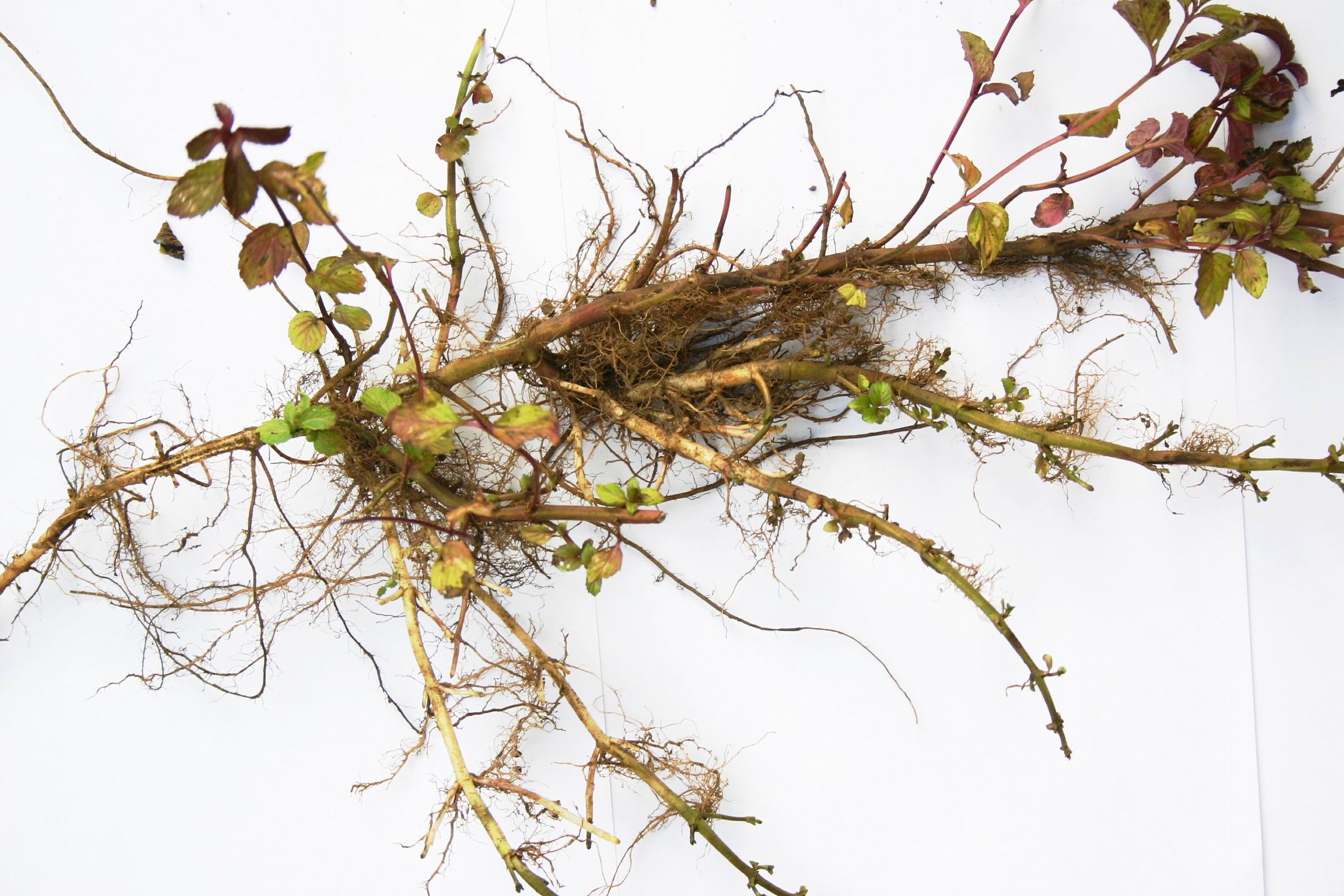
Stolons (modified shoots developing in the soil) of peppermint
Another very frequent goal of breeding is the changing the accumulation of active ingredients of the drug. Breeders strain for assuring an elevated level of the most important chemical compounds or optimizing the composition and proportion of ingredients. Thus, enhancement of essential oil content has been the main focus of selection of hyssop (Hyssopus officinalis) or lavender (Lavandula spp.) plant breeding. Increase of the level of flavonoids has been fixed as breeding aim in improvement of gene stocks of St. John’s Worth (Hypericum perforatum) and milk thistle (Silybum marianum) but an elevated level of fatty acids is necessary in seeds of oil pumpkin (Cucurbita pepo) or evening primrose (Oenothera erythrosepala). In some cases a complex of biologically active materials are present in the drug which may slow down the breeding process. In several species not only the total concentration but its composition is also important, e.g. proportion of carvone in essential oil of caraway, proportion of chamazulene in the essential oil of chamomile or the proportion of morphine among the alkaloids of poppy capsules.
In other cases breeders face the task to decrease or cease the presence of certain components of adverse effects. A special example in this context is poppy (Papaver somniferum), because a high alkaloid level may be the goal of breeding industrial varieties, however it should be avoided and minimized while breeding food varieties. Selection activity has been carried out in order to decrease the level of beta-thujone (e.g. Salvia officinalis) or the toxic pyrrolizidine alkaloids (e.g. Symphytum officinale). Concentration of heavy metals in the drug is becoming more and more important as a drug quality parameter. It has been described, that there is a difference in the accumulation potential among species and also among intraspecific genotypes in this respect. Therefore breeding for low accumulation potential of heavy metals is going to be a further goal of certain species, too (e.g. Hypericum perforatum, Linum usitatissimum).
In several species, visual performance of the drug is part of drug quality. Therefore improvement of morphological characteristics is frequently among the breeding goals of these taxa. Breeding of lemon balm (Melissa officinalis) or that of marigold (Calendula officinalis) should not decline of keeping an attractive green colour of the leaves and a deep orange colouration of the petals, respectively. Similarly, the characteristic spicy aroma of marjoram has been fixed as a breeding aim in several countries.
For the agricultural practice, plant characteristics enabling the application of intensive cultivation and/or postharvest methods, mechanisation, large scale technologies may be of special interest and therefore also frequent goals of breeding activity. These plant characteristics might stay in connection with growth dynamics, competition ability (e.g. earliness, weed suppression potential, feasibility for mechanical harvest) but may be in relation with propagation-biological features (e.g. closed capsule, non-flaking seeds, prompt germination, uniform flowering time), or morphological traits (e.g. size of seeds, form of the roots, location of leaves).
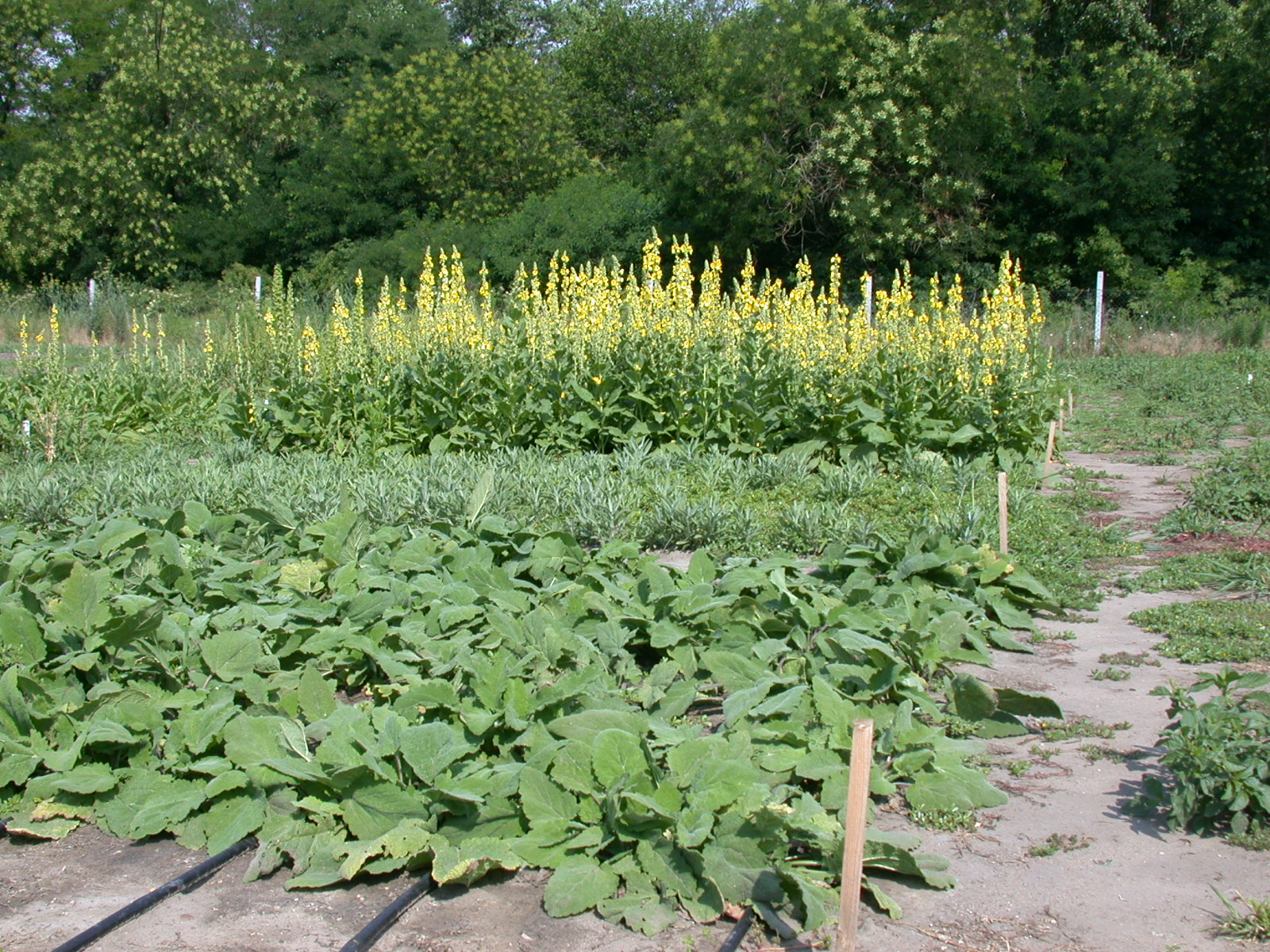
Annual variety of mullein (background) with the biennial “wild” type (foreground)
Development of resistant or tolerant genotypes has a great significance in breeding of medicinal plants, similarly to other crops. Unfortunately, this aspect has been marginally handled till now. Successful examples are the establishment of resistant clones of peppermint against Verticillium species. Breeding is going on for generating resistance in caraway (Carum carvi) and St. John’s Worth (Hypericum perforatum) against diseases caused by different fungi. An important goal should be the enhancement of tolerance against abiotic factors facilitating acclimation of plants to unfavourable climatic or edafic conditions. Thus, efforts are known for widening the spectrum of winter poppy (Papaver somniferum) varieties with enhanced frost tolerance and increasing the salt tolerance of safflower (Carthamus tinctorius) in special areas of the Middle East. Cultivation of arnica (Arnica montana) has only been successful after the development of its new variety (’Arbo’) of elevated tolerance against calcareous soils.
Breeding methods in genetic improvement of medicinal plants
The most frequently applied method in breeding of medicinal plants seems to be selection, each individual, mass or clonal selection as well. One of the first (“historical”) examples was the development of new strains of cinchona (Chinchona spp.) with increased capacity of active agent accumulation in the English colonies in India during the middle of the XIX. century. A big advantage of selection breeding is that generally it is the simplest and cheapest method. It needs less deep and species-specific genetic knowledge about inheritance of different traits. Its drawback is that this method is able to stabilize only the existing genetic variability of the populations. However, it has been successful in case of most medicinal plant species as they still have a wide genetic background of appropriate diversity.
Efficacy of selection may be accelerated by provocative environment – as it has been useful in the practice in breeding of poppy varieties of special alkaloid spectrum ('Monaco', 'Kék Gemona'). It might be effective primarily in selection for higher level of active materials if choosing the individuals which are able to accumulate the desired compounds even under unfavourable conditions. Experiments should be carried out in controlled condition, e.g. phytotron chambers.
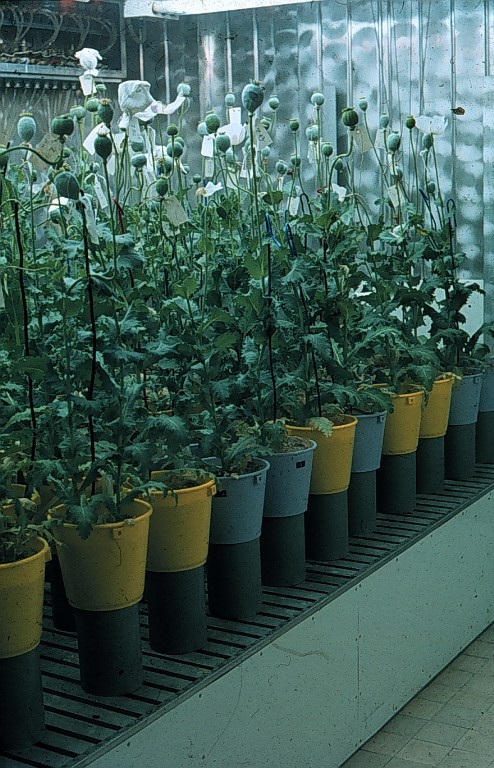
Control of selected poppy strains in phytotron chamber
Crossing as breeding method is more and more applied in medicinal plants, as it is an appropriate tool combining advantageous characteristics of two different genotypes. That was the goal in case of creating combinations between annual and biennial varieties of caraway (Carum carvi), or between different chemotypes of spearmint (Mentha spicata).
Both traditional crossing in vivo and fusions in vitro are followed by well oriented selection. Interspecific crossing between species is less frequent. The poppy variety ¢Kék Duna¢ (P. orientale x P. somniferum) has been established by this way. Crossing necessitates deep genetic and physiological knowledge on the target species (e.g. on floral biology, fertilization, combination ability, inheritance, etc.)
A prompt increase of productivity can be achieved by heterosis breeding. This method necessitates –beside appropriate scientific information – also numerous exact biological information; severe financial and also infrastructural requirements. It means the application of: inbred lines or haploids, male sterile analogues, expensive maintenance system. Therefore in the practice, F1 hybrids have only been developed till now in cultures where industrial interest requires strong protection (clary sage- Salvia sclarea, fennel- Foeniculum vulgare). Results are anticipated also for species where simpler methods have not been successful enough (marjoram, thyme).
Development of polyploid genotypes. The members of several genera constitute a polyploid row as it has been described e.g. for yarrow (Achillea spp.), mints (Mentha spp.) and valerian (Valeriana spp.). Increase of chromosome number however, is not always in connection with an increase of the drug mass or elevated accumulation of biologically active molecules. Use of polyploidy is still very rare in breeding of medicinal plants. In the practice tetraploid varieties broaden the choice of varieties only in case of some species like chamomile (Matricaria recutita) and dill (Anethum graveolens).
Applying mutation breeding for medicinal and aromatic plant species is not frequent yet, and its spreading can not be anticipated either. As results are extremely uncertain and obtainable by chance, moreover, species-specific knowledge and marker traits are usually lacking, its use for medicinal plants is realistic only in certain cases where no other methods have been able to provide success. As examples, the development of Verticillium resistant strains of peppermint and the creation of ergot strains of specific alkaloid spectrum can be mentioned. The Hungarian candidate variety of medicinal nightshade (Solanum laciniatum) of determined growth habit or the Polish variety ’Topas’ of St. John’s Worth ( Hypericum perforatum) have been developed also by this method. Gamma irradiation or chemical mutagens are applied as mutation agents.
Recently, molecular methods are spreading, too. Elaboration of in vitro techniques (tissue culture, regeneration) has been started already in the 1970s. Now there are well established technologies for several species (Carum carvi, Digitalis lanata, Mentha piperita, Datura stramonium, etc.), but their high cost restrict the practical application in breeding. Molecular genetic (mainly RAPD, SSR, AFLP) and isoenzyme markers are gaining an increasing significance also in genetic improvement of medicinal plant species. These results are used for sourcing of appropriate gene stocks for breeding (e.g. for hybrid components), for authentication of varieties and origin or purity of drugs. Gene transformation an obstacle of its broader application in many species seems to be the lack of knowledge about biosynthetic enzymatic systems and the determining genes. Research focusing on these aspects is however already going on by high intensity in numerous laboratories of the world. Successful transformants are already known for example in poppy, lavender, periwinkle (Catharanthus roseus) and peppermint. Nevertheless, introduction of transformed varieties into the practice is not expected in the very near future considering their high expenses and the international adjustment of GMO organisms.
Control questions
More answers are possible!

